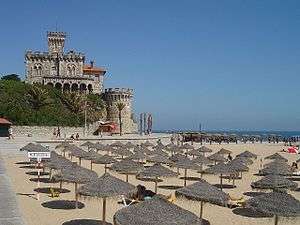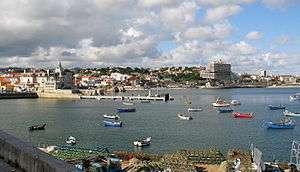Estoril
| Estoril | ||
| Civil Parish (Freguesia) | ||
 The beach of Tamariz, in the central coastal area of Estoril | ||
|
||
| Official name: Freguesia de Estoril | ||
| Country | Portugal | |
|---|---|---|
| Region | Lisbon | |
| Subregion | Greater Lisbon | |
| District | Lisbon | |
| Municipality | Cascais | |
| Localities | Alapraia, Alto dos Gaios, Areias, Atibá, Galiza, Bairro da Martinha, Bairro Sto António, Bairro Fausto Figueiredo, Estoril, Livramento, Monte Estoril, Monte Leite, São João do Estoril, São Pedro do Estoril | |
| Center | Estoril | |
| Lowest point | Sea level | |
| - location | Atlantic Ocean | |
| - elevation | 0 m (0 ft) | |
| Length | 4.96 km (3 mi), Northwest-Southeast | |
| Width | 4.02 km (2 mi), Southwest-Northeast | |
| Population | 26,397 (2011) | |
| Timezone | WET (UTC0) | |
| - summer (DST) | WEST (UTC+1) | |
| Postal Zone | 2765-281 | |
| Area Code and prefix | (+351) 214 XX XX XX | |
| Demonym | Santo António | |
| Wikimedia Commons: Estoril | ||
| Statistics: Instituto Nacional de Estatística[1] | ||
| Website: http://www.jf-estoril.pt/ | ||
| Geographic detail from CAOP (2010)[2] produced by Instituto Geográfico Português (IGP) | ||
Estoril (Portuguese pronunciation: [(ɨ)ʃtuˈɾiɫ]) is a town and a former civil parish in the municipality of Cascais, Portugal, on the Portuguese Riviera. In 2013, the parish merged into the new parish Cascais e Estoril.[3] In 2011, the population of Estoril included 26,397 inhabitants, occupying an area of approximately 8.79 km2 (3.39 sq mi).
History

The territory of Estoril has been inhabited for centuries, owing to its climatic conditions and favourable environment.[4] Throughout the civil parish there are scattered remains of these early communities — Phoenicians, Romans and Arabs selected this area for its strategic place in Western Europe.[4] There are remains of Roman villas in the parish that push back the history of the region to the first millennium, when the settlements of the coast were dependent on the fishing ports. From these settlements, Estoril inherited a rich cultural heritage, architecture, toponymy, habits and customs.[4]
In 1147, during the Reconquista, the region was brought under Christian control.[4]
Owing to its strategic place, the region was intimately linked to the Portuguese Age of Discovery and all the dynamic social and cultural upheavals that it originated.[4]
Its solid fortifications are a testament to the innumerable attacks by Spanish, French and English pirates and privateers. The many forts that dot the coastline are symbols of the resistance and battles that secured Portuguese independence and national interests.[4]
At the end of the monarchy, it was in the waters of Estoril that many sought refuge and escape. Aristocrats, nobles and others escaped through the ports along the Estoril coast to flee from the Republican forces.[4]
In the hilltop enclave of Monte Estoril (situated between Estoril and Cascais), is the Verdades-Faria Museum, built in 1917 by Jorge O'Neil.[4] In 1942, the building was bought by Mantero Belard and dedicated to the support of the arts and artists. Following his death, the building was donated to Cascais Council under the name of Verdades Faria and eventually housed the Regional Portuguese Music Museum.
During the Second World War, the region was the centre of spies and diplomatic secrecy, situations that provided the region with a cosmopolitan atmosphere and sophistication.[4] Due to the vision of Fausto Cardoso de Figueiredo and his business partner Augusto Carreira de Sousa, it became an international tourist destination both during and after the Second World War.[4] During that time, several dignitaries and exiles came to Estoril: Miklós Horthy, the regent of Hungary (lived and died in exile after the Second World War); the Infante Juan, Count of Barcelona (father of Juan Carlos I of Spain) and the King resided in the territory, as did Umberto II of Italy and Carol II of Romania.[4] It was also in this location that former Portuguese dictator António de Oliveira Salazar had a summer house. It was Salazar who ordered the construction of the E.N.6 motorway, more commonly referred to as the Avenida Marginal, in order for him to quickly travel by car between Cascais and Lisbon (until then the accessway was nothing more than a dirt road, where traffic could only circulate at low velocities and make frequent stops).[4] The roadway permitted the dictator to travel rapidly, and with fewer stops, it wasn't possible for him to be recognized easily in transit.[4] The engineer John Tojeiro was born in Estoril.
Geography
| Population of Estoril (1849–2011) | ||
|---|---|---|
| Year | Pop. | ±% |
| 1970 | 15,440 | — |
| 1981 | 24,312 | +57.5% |
| 1991 | 23,962 | −1.4% |
| 2001 | 23,769 | −0.8% |
| 2011 | 26,397 | +11.1% |


The Estoril coast is relatively close to Lisbon, the Portuguese capital; it extends from Carcavelos, 15 kilometres (9.3 mi) from the capital, and stretches as far as the beach of Guincho (sometimes referred colloquially as the Costa de Estoril-Sintra or Costa de Lisboa. Estoril includes several smaller boroughs and localities along the coastline, namely (from east to west): São Pedro do Estoril, São João do Estoril, Santo António do Estoril (or simply Estoril) and Monte Estoril, as well as other to the interior.
Estoril is popularly recognized for the Casino Estoril, widely regarded as Europe's largest casino.[4]
Culture
The Verdades-Faria Museum hosts an important collection of musical instruments related to popular music, assembled by Michael Giacometti.
Christine McVie, from the band Fleetwood Mac, wrote a song called "Nights in Estoril" for their album Time.
Sport
The major local sports club is the Grupo Desportivo Estoril Praia.
Motorsport events are frequent at the Estoril Circuit, although Formula One is no longer on the circuit's calendar. This was due to the circuit not coming up to FIA safety standards, leading to the 1997 event being cancelled. Following a review on safety, Estoril was reshaped in 1999, the first two corners being affected the most. Today's circuit is 4.183 km (2.599 mi) in length and is run in a clockwise fashion. The circuit currently hosts international motorcycling events (MotoGP), among other lower formula events.
Education
The community hosts a kindergarten and elementary school campus of the German School of Lisbon.[5]
References
- ↑ INE, ed. (2010), Censos 2011 - Resultadas Preliminares [2011 Census - Preliminary Results] (in Portuguese), Lisbon, Portugal: Instituto Nacional de Estatística, retrieved 1 July 2011
- ↑ IGP, ed. (2010), Carta Administrativa Oficial de Portugal (in Portuguese), Lisbon, Portugal: Instituto Geográfico Português, archived from the original on May 21, 2011, retrieved 1 July 2011
- ↑ Diário da República. "Law nr. 11-A/2013, page 552 34" (pdf) (in Portuguese). Retrieved 20 July 2014.
- 1 2 3 4 5 6 7 8 9 10 11 12 13 14 Junta Freguesia, ed. (2011). "História" (in Portuguese). Estoril (Cascais), Portugal: Junta Freguesia de Estoril. Retrieved 8 February 2012.
- ↑ "Kontakt"/"Contactos." German School of Lisbon. Retrieved on May 5, 2016. German: "Deutsche Schule Lissabon Kindergarten, Grundschule, Gymnasium Rua Prof. Francisco Lucas Pires 1600-891 Lisboa Portugal" and "Deutsche Schule Lissabon - Standort Estoril Kindergarten, Grundschule Rua Dr. António Martins, 26 2765-194 Estoril Portugal" ; Portuguese: "Escola Alemã de Lisboa Jardim Infantil, Escola Primária e Liceu Rua Prof. Francisco Lucas Pires 1600-891 Lisboa Portugal" and "Escola Alemã de Lisboa - Dependência do Estoril Jardim de Infância, Escola Primária Rua Dr. António Martins, 26 2765-194 Estoril Portugal"
